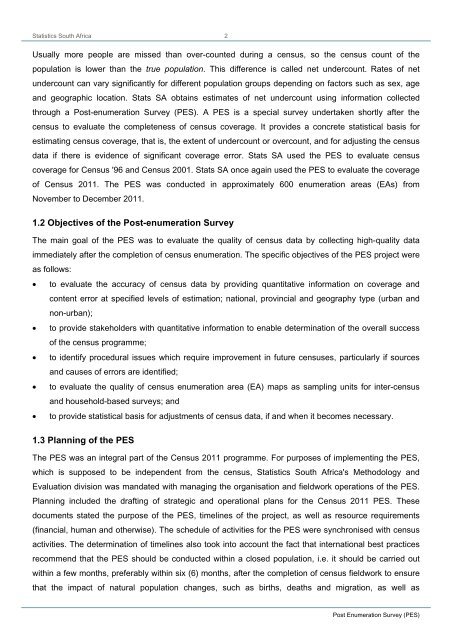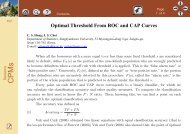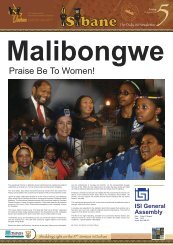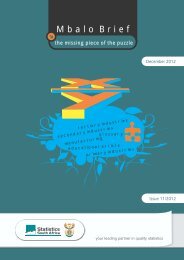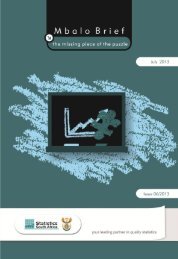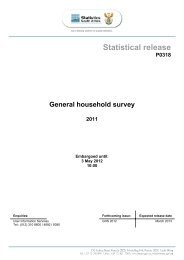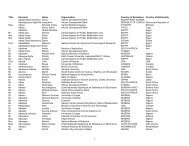Post-enumeration Survey (PES) - Statistics South Africa
Post-enumeration Survey (PES) - Statistics South Africa
Post-enumeration Survey (PES) - Statistics South Africa
You also want an ePaper? Increase the reach of your titles
YUMPU automatically turns print PDFs into web optimized ePapers that Google loves.
<strong>Statistics</strong> <strong>South</strong> <strong>Africa</strong><br />
2<br />
Usually more people are missed than over-counted during a census, so the census count of the<br />
population is lower than the true population. This difference is called net undercount. Rates of net<br />
undercount can vary significantly for different population groups depending on factors such as sex, age<br />
and geographic location. Stats SA obtains estimates of net undercount using information collected<br />
through a <strong>Post</strong>-<strong>enumeration</strong> <strong>Survey</strong> (<strong>PES</strong>). A <strong>PES</strong> is a special survey undertaken shortly after the<br />
census to evaluate the completeness of census coverage. It provides a concrete statistical basis for<br />
estimating census coverage, that is, the extent of undercount or overcount, and for adjusting the census<br />
data if there is evidence of significant coverage error. Stats SA used the <strong>PES</strong> to evaluate census<br />
coverage for Census '96 and Census 2001. Stats SA once again used the <strong>PES</strong> to evaluate the coverage<br />
of Census 2011. The <strong>PES</strong> was conducted in approximately 600 <strong>enumeration</strong> areas (EAs) from<br />
November to December 2011.<br />
1.2 Objectives of the <strong>Post</strong>-<strong>enumeration</strong> <strong>Survey</strong><br />
The main goal of the <strong>PES</strong> was to evaluate the quality of census data by collecting high-quality data<br />
immediately after the completion of census <strong>enumeration</strong>. The specific objectives of the <strong>PES</strong> project were<br />
as follows:<br />
• to evaluate the accuracy of census data by providing quantitative information on coverage and<br />
content error at specified levels of estimation; national, provincial and geography type (urban and<br />
non-urban);<br />
• to provide stakeholders with quantitative information to enable determination of the overall success<br />
of the census programme;<br />
• to identify procedural issues which require improvement in future censuses, particularly if sources<br />
and causes of errors are identified;<br />
• to evaluate the quality of census <strong>enumeration</strong> area (EA) maps as sampling units for inter-census<br />
and household-based surveys; and<br />
• to provide statistical basis for adjustments of census data, if and when it becomes necessary.<br />
1.3 Planning of the <strong>PES</strong><br />
The <strong>PES</strong> was an integral part of the Census 2011 programme. For purposes of implementing the <strong>PES</strong>,<br />
which is supposed to be independent from the census, <strong>Statistics</strong> <strong>South</strong> <strong>Africa</strong>'s Methodology and<br />
Evaluation division was mandated with managing the organisation and fieldwork operations of the <strong>PES</strong>.<br />
Planning included the drafting of strategic and operational plans for the Census 2011 <strong>PES</strong>. These<br />
documents stated the purpose of the <strong>PES</strong>, timelines of the project, as well as resource requirements<br />
(financial, human and otherwise). The schedule of activities for the <strong>PES</strong> were synchronised with census<br />
activities. The determination of timelines also took into account the fact that international best practices<br />
recommend that the <strong>PES</strong> should be conducted within a closed population, i.e. it should be carried out<br />
within a few months, preferably within six (6) months, after the completion of census fieldwork to ensure<br />
that the impact of natural population changes, such as births, deaths and migration, as well as<br />
<strong>Post</strong> Enumeration <strong>Survey</strong> (<strong>PES</strong>)


